Departmental
Poster at AGU meeting, San Francisco: Astrid
crater, near Bridgetown, NS
Ian Spooner and Rob Raeside attended the American Geophysical Union conference in San Francisco in early December, where they presented a poster of a research project that has been undertaken by most of the members of the department. The poster documents the discovery of an impact crater on the South Mountain, south of Bridgetown, likely formed by a
meteorite or comet impact about 12,000 years ago. While the oval crater is well documented from magnetic, ground penetrating radar, and topographical features, its confirmation as an impact structure came from mineralogical analysis of ejecta and surrounding rocks. Its preservation indicates a post-glacial origin and, interestingly, an inorganic layer found in lake sediment records elsewhere in Nova Scotia may represent the sudden input of sediment from such an event. Woody material above the inorganic layer dates to 12,504 BP.
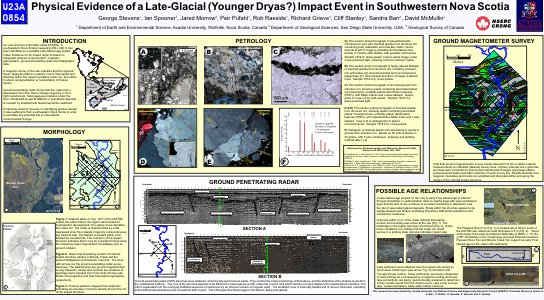
The poster attracted much attention at the conference, because a recently released paper postulates that a globally felt impact at 12,900 BP was responsible for the extinction of the Ice Age megafauna and possibly even the Clovis culture of people in North America. This impact has (had?) no known associated structure, and much interest surrounded the
Astrid crater at Bridgetown as a possible component of this event.
18 December 2007
New cathodoluminesce equipment set up in E&ES
Dr. Peir Pufahl took delivery of a new cathodoluminescence (CL)
microscope at the end of November. CL is the phenomenon whereby
light
is emitted by a material when it is impacted by an electron beam and
is used
to study the structure within materials. When combined with a
petrographic microscope, the texture of a rock can be viewed
simultaneously
with CL and light. Here Peir is checking out the optics of the
system.

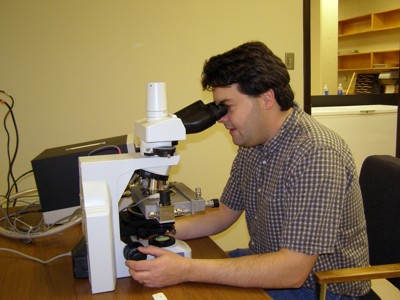
A full view of the system can be seen in
this photo
29 November 2007
Gabe Nelson winner of best poster at GSA meeting (Denver)

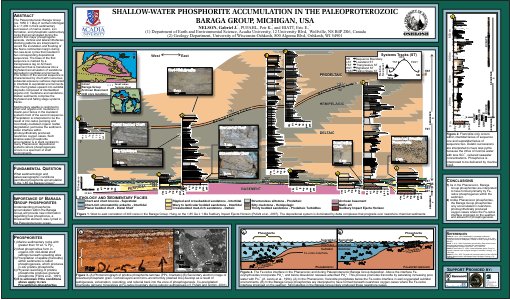
Graduate student Gabe Nelson was awarded the best
poster in
sedimentology at the recent Geological Society of
America
conference in Denver, Colorado. His poster, entitled
"Shallow-water Phosphorite Accumulation in the
Paleoproterozoic
Baraga Group, Michigan, USA" documents his findings in
his MSc
thesis, under the supervision of Dr. Peir Pufahl.
21 November 2007
Kara-Lynn Scallion winner of AUGC poster award

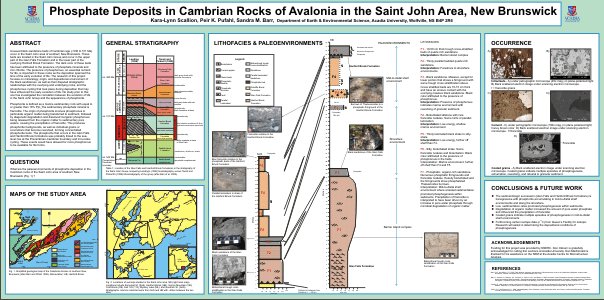
Honours student Kara-Lynn Scallion shared the award
of the
best poster at the recent Atlantic Universities
Geological
Conference, held at St. Francis Xavier University,
Antigonish,
NS. Her poster, entitled "Phosphate Deposits in
Cambrian
Rocks of Avalonia in the Saint John Area, New Brunswick"
documents her initial studies using field mapping and
scanning
electron microscopy to identify the source of these
phosphatic
rocks.
In the oral communications, Tim Cross also did a fine
job reporting on the his findings from his summer
(winter?) job
and honours thesis, "Lithogeochemical vectors toward
gold
mineralization in the Amaranth Vein, Waihi, New
Zealand".
5 November 2007
Another Award!
On October 28, 2007 Mary Samolczyk,
and
Environmental Science student, won the best student paper prize at the
Atlantic Universities Geological Conference at Dalhousie University in
Halifax. The title of Mary's presentation was "Uranium
and Arsenic in Ground Water in Grand Pré, Nova Scotia: An
Interdisciplinary
Study", and was
co-authored with supervisors Drs. Ian Spooner and Cliff Stanley, and
Professor Linda Lusby. Mary is studying the trace metal concentrations
in
well waters of the Grand Pré
area because recent changes to environmental regulations in Nova Scotia
mean
that some of the waters in the Grand Pré
area are no longer in compliance with
the maximum allowable
concentration
regulations.
Congratulations, Mary!
1 November 2007
Duke of Edinburgh Award winner: Katherine Dugas
Katherine Dugas was one of four final-year Acadia students who
received
a Duke of Edinburgh Award (Gold level) from HRH Prince Edward at a
recent
ceremony in Halifax. Katherine is second from the left in this
photo, and is
accompanied by Kathryn Cleveland, Christina Swett and Mary Jane
Tingley.

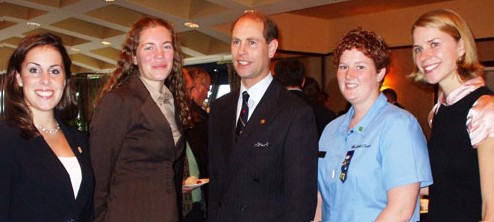
To earn the award she completed at least 60 hours of community
service
over twelve months, 50 hours of physical activity over 25 weeks, an
expedition of four days/3 nights, learned a new skill for twelve
months and a residential project. The residential project is completed
over at least a week working with people you have not interacted much
with before. Some of the activities she undertook were referee in
basketball,
cross country running, track & field, volunteer leader with the
Girl Guides of Canada,
a canoe trip in Kejimkujik National Park and Tidal Impact.
18 October 2007
Nelson O'Driscoll - Acadia's newest Canada
Research Chair
Acadia University is pleased to announce that Dr. Nelson O'Driscoll
has been
named a Tier 2 Canada Research Chair in Natural Sciences and
Engineering by
the Canada Research Chairs Program. Nelson's appointment as the
Canada Research Chair in Environmental Biogeochemistry was recently
announced in Calgary by the Secretary of State Diane Ablonczy on behalf
of Jim Prentice, minister of industry and minister responsible for the
Canada Research Chairs Program.
"Building a larger base of scientific expertise and enhancing Canada's
international reputation for research excellence are key elements of
Mobilizing Science and Technology to Canada's Advantage, our
government's new Science and Technology Strategy," said the Honourable
Diane Ablonczy. "Our Government recognizes the importance of doing more
to help transform and commercialize scientific and technological
innovations. This in turn will help create better jobs, increase
economic growth and improve our quality of life."
Dr. O'Driscoll is studying the impact of climate change on mercury
contamination in freshwater ecosystems by analyzing the effects of
temperature, precipitation, and solar radiation on the contaminant. He
hopes his research will contribute to the development of effective
measures to reduce exposure to this contaminant as climate change
occurs.
"This is an important area of research for Canada as we have lots of
fish and lots of mercury in our freshwater systems," explained
O'Driscoll, who has published a book on mercury levels in the Kejimkujik
Park ecosystem, which are the highest in Canada.
"Understanding the relationship between climate change and the long-term
activity and effects of environmental contaminants is crucial for the
well-being of both human and animal populations," he said.
21 September 2007
Linda Lusby invited to Trudeau Foundation conference
Department head Linda Lusby received an invitation to attend an
upcoming
conference of the prestigious Trudeau Foundation on "A
Climate of Reconciliation: Economy, Social Justice and the
Environment"
in Calgary in November. This is a considerable honour for Linda,
who
may be the first person from Acadia invited to attend a Trudeau
Foundation
conference. More information can be found about
the Foundation or about the
conference.
10 September 2007
Acadia faculty and students discover Ancient Sudbury meteorite
created
mega-tsunami
by Margaret Munro CanWest News Service, published in StarPhoenix
(Saskatoon), the Montreal Gazette, Edmonton Journal, Calgary Herald,
The
Province (Vancouver), The Vancouver Sun, the Times Colonist
(Victoria), and the
Amherst Daily News.
A mountain-sized meteorite appears to have created Sudbury's
gigantic crater and sent a tsunami racing though ancient oceans, say
scientists who have uncovered a thick layer of debris the
extraterrestrial
interloper hurled all the way into Michigan. A Canadian-U.S. team
says the
two-to-four-metre-thick layer of "ejecta," which they found south of
Lake
Superior, bears the clear signature of a meteorite. Perhaps even
more
intriguing, they say the "ejecta" appears to have been stirred up by
a
"mega-tsunami," possibly two, that swept through the ancient oceans
after
the space rock hit. "The material blown out of the crater was
reworked
during deposition by a tsunami," says
Peir Pufahl, lead author of a report on the find in the
September
editions of the journal
Geology. He says shock waves generated by the impact of the
meteorite,
believed to have been about the size of Mount Everest, would have
been
powerful enough to generate giant waves in nearby oceans. "We also
get
beautiful rock preserved in tear drops just as you'd expect if you
had
molten rock flying through the atmosphere and it cooled," Pufahl
said in a
interview. The Sudbury crater, the second largest ever found, was
formed
1.85 billion years ago and is much bigger than the one linked to the
demise
of the dinosaurs. Some have suggested a comet carved out the crater,
which
originally measured up to 280 kilometres in diameter. But the
material
uncovered in northern Michigan points to a meteorite, since it
contains an
unusually high concentration of iridium, which occurs in low amounts
in icy
comets but in high levels in space rocks. The "ejecta layer," which
the
geologists found buried a kilometre underground south of Lake
Superior,
builds on similar evidence uncovered near Thunder Bay, Ont., a few
years
ago. The newly found material not only contains high levels of
iridium and
"melt drops" but also "shocked" crystals deformed by the intense
energy, and
evidence of reworking by a tsunami, the team reports. The impact of
the
meteorite would have been felt globally but most of the evidence has
eroded
away over time. "It's like a book with 90 per cent of pages
missing," says
Pufahl. He says the huge cloud of gas and molten rock hurled into
the
atmosphere would have put photosynthesis on hold for an extended
period and
may be linked to a "long lull" in the evolution of early life.
Computer
models have estimated the space rock could have been close to 20
kilometres
across and travelling 20 kilometres a second, or 1,200 kilometres a
minute,
when it slammed into Earth. "That energy has to go somewhere," says
Pufahl.
"Some of it goes into deforming the rock it slams into, some of it
obliterates the rock it slams into and throws it in to the
atmosphere, and
some of it is transmitted away from the impact as shock waves. It is
those
shocks waves that would impact on water to cause tsunamis."
The paper was written by Peir Pufahl, Clifford Stanley, and Gabe
Nelson (Acadia University), Eric Hiatt and Cole Edwards (University
of
Wisconsin - Oshkosh) and Jared Morrow (San Diego State University)
and
published in
Geology in September 2007.
[See also the article in
Discovery.com
-a bit more sensational, perhaps, with a video of the NASA planetary
protection officer whose job is to protect the Earth from
"asteroids".
]
August 30, 2007
From wine to the mine (Cliff Stanley's research in focus in
Australia)
by Janine MacDonald, ScienceNetwork, Western Australia
Wine: an exceptionally good vintage for extraction? Australia's
trademark
grassy sauvignon blanc may soon be used for more than the afternoon
tipple.
Scientists from Australia and Canada hope to use wine and soft drink
to
extract metals from soils to decide viable sites for mining metals
such as
silver, zinc, copper and nickel. CSIRO's exploration and mining
researcher
Dr Ryan Noble and Dr Cliff Stanley from Acadia University have been
experimenting with cool drinks and wine to find a cheaper
alternative to
current extraction methods. The scientists compared a Spanish red
wine
tempranillo, Coke, Pepsi and Diet Coke with more traditional
extraction
methods to see how they fared. For cola devotees, apparently Pepsi
was
better than Coke and Diet Coke was better than Pepsi - for mineral
extraction that is. But the red wine was superior to all. "I have no
doubt
that that you could use white wine and it would work pretty
similarly," Dr
Noble told ScienceNetwork WA.
The study, expected to be published in the journal Geochemistry:
Exploration, Environment, Analysis, found the soft drink and wine
solutions
were as good as or better than the commonly used extraction
solutions. The
availability of the solution is its attraction. In fact, the study
was
prompted by the techniques of some commercial labs which refused to
disclose
the solutions they used. "The use of expensive and proprietary
analytical
procedures may not produce any better result than using common
beverage
solutions as soil extraction reagents," said Dr Noble. "Many newer
extractions have glossy brochures and descriptions of their
abilities to
work, but none have been described as 'young and fruit driven with
plum and
blackcurrant overtones'." Dr Noble, who works at Bentley's
Co-operative
Research Centre for Landscape Environments and Mineral Exploration,
and his
co-author, first revealed the findings at the International Applied
Geochemistry Symposium in Oviedo, Spain in June. The research is
under peer
review. Dr Noble said soft drink and wines contain a lot of weak
organic
acids such as citric acid - the chemical responsible for the sour
taste in
lemons, limes and oranges. The acids can dissolve metals in soil,
releasing
"mobile metals" into the solution where they bind to organic
compounds to
create metal molecules that can be detected in the laboratory. The
acids can
be used to find out if soils contain elevated levels of certain
metals and
to highlight areas where they would be in commercial concentrations.
Western
Australia produces about 15 per cent of the world's nickel.
Australia is the
largest producer and exporter of zinc and is in the top five or six
producers of silver and copper in the world. Of course, most West
Australian
mine sites are "dry" and no alcohol is permitted on site.
Fortunately, most
extraction work is done offsite in laboratories. There would be few
laboratory jobs where you can drink the unused solution.
29 August 2007
Welcome to Lynn Graves
As of 13 August, Lynn Graves will be the permanent, fulltime
secretary in the Department of Earth and Environmental Science. Lynn
has previously worked on a temporary basis with both Geology and
Environmental Science and we are delighted to welcome her to her new
permanent position. Lynn can be found in the E&ES Main Office in
Huggins Science Hall, Rm. 327. Her phone extension is 1208.
13 August 2007
Farewell to Janet Harnum, secretary-technician,
hello to
Linda Lusby, acting department head
On 31 July, Janet Harnum finished up as the secretary-technician
in the
department. Janet has been the keystone of the department for the
past
6 years (less occasional time off to enjoy her sons Sullivan and
MacKenzie
in their first years), and we know we will miss her. However, her
time
has come to brave the business world, as she opens a vegetarian
restaurant
in Main Street, Wolfville. Good luck with it, Janet, but you'll
likely
still be feeding us! We hope to announce Janet's replacement in a
few
weeks - in the meantime Lynn Graves will be answering the phone (and
doing
quite a lot of other things too!)
On 1 August, Linda Lusby took over as department head in the Earth
and
Environmental Science department for an 11-month acting role, when
Rob
Raeside is working as acting Dean of Science. Prof. Lusby has taught
in the
Environmental Science program since it was first established, so is
well
known to that half of the department. She will split her office
time
between the "North Lodge" (Huggins) and the "Chiller" (K.C. Irving
Centre) as administrative and teaching duties call her.
1 August 2007
International Applied Geochemistry Symposium,
Oviedo,
Spain
Five present or past members of the department attended the IAGS
symposium, in Oviedo, northern Spain, from 14-19 June. Recent
graduate
Rafael Cavalcanti de Albuquerque writes "The
conference consisted of four days of lectures and poster
presentations, a
field trip, a day course by Dr. Stanley, and social and tourist
activities.
My participation involved attendance at the conference and a poster
presentation entitled "The Southern Nova Scotia Wine Terroir: A
geological
study of the geochemistry of soils with a focus on cation exchange
capacity". The conference was a great opportunity to learn about
what is
being researched in geochemistry in several countries, and to meet
students
and professional geochemists. Acadia University had a strong
presence in the
conference. Besides the poster that I presented, Tansy
O'Connor-Parsons and
Jeff Bigelow gave talks related to their theses at Acadia, and Cliff
Stanley
presented a poster and conducted a day-long course on Pearce Element
Ratio
Analysis. All of the Acadia presentations received very good
comments. The
Acadia attendees (which also included José
Texidor-Carlsson) made a good presence at the conference events as
it seemed
to me that all of us met many people, had interesting chats and made
good
contacts. I was also very glad to realize that the Department at
Acadia is very well known to geochemists in other countries. I
hardly ever
had to explain where the university or the town of Wolfville are
when
meeting people from countries such as Spain, Chile, England or
Australia. In
my opinion this is an indicator that our department has been
offering
quality degrees and conducting relevant research for many years.
Regarding my participation, I believe that the highlights were the
people
that I met and the discussions that I had. During the first day of
the
conference we formed a group of poster presenters where each person
presented his/her poster to the rest of the group. Each presentation
would
be followed by questions and discussions. In previous conferences I
attended
I realized that student presenters would often just stay in front of
their
posters and, as few people would walk by, would not have much chance
to
actually present their research. In this conference, however, by
forming
this group we managed to properly present our research several times
and
engage in interesting discussions. Two posters out of this group
seemed
especially interesting to me. They were a poster by a PhD student
who is
using discharge to evaluate river contamination in southern Spain,
and a
poster by a student in Australia who looks at tree leaves chemistry
to map
potential areas of economical mineral deposits. Another interesting
idea
that I saw was that some of the poster presenters brought 8 x 11
copies of
their posters to give away. I think this is a good and easy way to
help
communicate the research being done as the attendees can take copies
of the
posters home, review them and get in touch with the presenters later
to ask
questions and exchange ideas. I do not remember seeing this in
Eastern
Canada and I think it is something to consider doing for future
conferences.
The
conference was certainly a good opportunity to make contacts. A
number of
university faculties were looking for potential masters and PhD
students in
Canada and other countries. Several companies were present and very
open to
talk about career opportunities. I had good conversations about
career and
graduate degrees opportunities even though I was not aggressively
looking
for either at the present moment as I have just started a job. I
also met
some geologists from Portugal who are part of a group of geologists
that
work with vintners on researching the influence of geology on wine
production. I intend to keep in touch with them in order to exchange
some
ideas and see if they have publications that might be helpful to the
paper
that I will be writing on the topic of my honours thesis.
The
next IAGS conference will take place in Fredericton, New Brunswick
in 2009.
This will hopefully make it easier for Acadia students and
professors to
attend. I felt very privileged to be able to attend a conference of
such a
high level at a very early stage of my career. It gave me a very
good
perspective of what is ahead of me in both the professional and
academic
areas. It was also a fine opportunity to make some good contacts and
meet
people. For these reasons, I believe that the 2009 conference should
be
advertised at Acadia, and any student with some interest in
geochemistry
should attend it.
23 July 2007
Jérôme Remick III Award to Sandra Barr's student for the third
time
For the third year running one of Sandra Barr's students has won the
Jérôme
Remick Award (Bronze level), given for the best posters at the
GAC-MAC
meeting each year. This year it was Duane Petts, who is a MSc
student
at the University of Western Ontario, but is supervised in part by
Sandra,
who was the winner of the $800 award after the meeting in
Yellowknife in
May. Duane's poster was entitled 'Oxygen isotope geochemistry of
Late
Proterozoic plutonic-volcanic sequences of the Mira Terrane, Cape
Breton
Island, Nova Scotia'. The poster is co-authored by Duane Petts, Fred
Longstaffe, Joanna Potter and Sandra Barr. Last year Heather
Wolczanski (BSc Hons, 2006) won the same award, and two years ago it
was won
by Cameron Bartsch - both students of Sandra at Acadia.
16 July 2007
Thesis Defence:
José Texidor-Carlsson
On Friday afternoon, 1 June, José Texidor-Carlsson
successfully
defended his thesis on "Metallogeny
of the Eastern Caledonia Highlands, southern New Brunswick". In
it
he investigated 58 mineral occurrences in southeastern New
Brunswick,
identified four that deserved further attention and, using Pearce
element
ratio analysis, identified the nature of alteration and
mineralization
responsible for these showings. José is a graduate of the Open
University,
UK. His thesis was jointly supervised by Sandra Barr and Cliff
Stanley. He is currently working in mineral exploration studies in
northern
Ontario.
1 June 2007
Yellowknife 2007
Cliff Stanley and Rob Raeside attended the GAC-MAC conference in
Yellowknife in May. Cliff presented a poster, co-authored with his
PhD
student David Murphy (U. Western Australia), entitled "Documenting
geochemical, physical, and thermodynamic changes associated with all
possible geochemical reactions in rocks using Gale vector space:
Metasomatic
examples from diamondiferous kimberlites and Ni laterite deposits."
Rob
spent most of his time in the Laurentian and Greenland sessions,
catching up
on the recent developments in Shield geology and fretting about the
number
of lectures he needs to update. For both, it was a first trip
north,
and into the boom-town environment of diamond mining. Cliff was
able
to participate on the field trip to Diavik and Ekati mines. It was
also a
good chance to catch up on several alumni, who now reside in
Yellowknife: As
a member of the organizing committee for the conference, Diane
Baldwin was
intercepted many times shuffling equipment around the city for the
next
session. Kelly Mahoney works as advisor to the Minister of Mines for
NWT.
Gordon Clarke also managed to stop by for a day between jobs
investigating
new mine sites for his company North Arrow Resources.
29 May 2007
Kara-Lynn Scallion and Sandra Barr as a CBC focus
Kara-Lynn Scallion (along with supervisors Peir Pufahl and
Sandra Barr)
were happily investigating outcrops in Saint John, NB, on 14 May
when the
CBC vans drove by and asked for an interview. Kara-Lynn and Sandra
described the regional geology and importance of these outcrops,
which
bridge the Precambrian-Cambrian boundary. Their interview was taped
for broadcast on Victoria Day.
21 May 2007
Twenty-three students graduate at Spring Convocation
Acadia sent 23 graduates out into the world at the spring
convocation on
14 May. BSc (Honours) degrees were awarded in Geology to Geoff
Baldwin and
Crystal Laflamme, in Environmental Geoscience to Rafael Cavalcanti
de
Albuquerque and in Environmental Science to Meredith Batley, Cait
Champion,
Susanne MacDonald, Megan Masters, Andrea Rivers, Mary Samolczyk and
Ty
Smith. B.Sc. graduates were Bryon Angevine, Ge Bao, Lauren
Bercovitch,
Dustin Chaffee, Jenna Reid and Andrew Scott (Environmental Science),
Erin
Dodge, Ryan Jensen, Teri Lawrence, Kim Markvoort, Meredith Roik and
Esther
terMeer (Geology), and Rebecca Jones (Environmental Geoscience).
The
University Medal in Environmental Geoscience was awarded to Rafael
Cavalcanti de Albuquerque and the University Medal in Environmental
Science
went to Cait Champion.
15 May 2007
Two new adjunct professors appointed: Lee Groat, Eric Hiatt
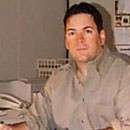
|
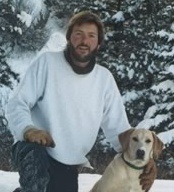
|
| Lee Groat | Eric Hiatt (at left!) |
The department is pleased to welcome two new adjunct
professors, both in collaboration with Peir Pufahl. Eric Hiatt is
no
stranger to Acadia, have spent part of his recent sabbatical leave
here.
Eric usually works at the University of Wisconsin, Oshkosh, and will
be
working with Peir on Precambrian ironstones in Labrador this
summer.
Lee Groat is a professor of mineralogy at UBC, and will be
co-supervising
graduate student Dan MacDonald in his investigations of
mineralization in
Yukon.
11 May 2007
Atlantic Geoscience Society annual colloquium
A small army of professors and students attended the annual
Atlantic
Geoscience Society colloquium in Moncton, NB, on the weekend of 2-4
February. Several attendees gave papers: Cliff Stanley (Documenting
the physical changes and thermodynamic effects of geochemical
reactions: a
metasomatic example in Gale vector space), Gabe Nelson and Peir
Pufahl (Precambrian
phosphorite accumulation in the Paleoproterozoic Baraga Group,
Michigan, USA),
Rafael Cavalcanti de Albuquerque, Ian Spooner and Cliff Stanley (The
southern Nova Scotia wine terroir: a geological and pedological
study of the
geochemistry of soils from vineyards with a focus on cation exchange
capacity) and Ian Spooner and Rob Raeside (Global warming,
climate
change and geoscientists: a volatile mix), or posters: Geoff Baldwin
and
Peir Pufahl (The
sedimentology and diagenesis of a Mississippian brachiopod biostrome
in the
vicinity of Newport Landing, Hants County, Nova Scotia), Crystal
Laflamme and Cliff Stanley (Petrology
of the Triple Seven Zn-Cu volcanic hosted massive sulphide deposit,
Flin
Flon, Manitoba), Sheri Lyon, Sandra Barr and Sonya Dehler (Source(s)
of magnetic and gravity anomalies south of Cape Breton Island, Nova
Scotia,
and onshore-offshore geological correlations), Mary Samoczyk,
Ian
Spooner, Cliff Stanley and Linda Lusby (Local
stratigraphy and groundwater chemistry in the Grand Pré region, Nova
Scotia:
contamination sources and mitigation strategies), and Doug
Stiff, Chris
Hopkinson, Ian Spooner and Tim Webster (Using
climate data, landscape parameterization, and a LiDAR generated
digital
elevation model to map flood risk in Oxford, Nova Scotia).
8 February 2007
Earth and Environmental Science Learning Centre
Since its inception in January 2007 the Earth and
Environmental Science Learning Centre (EESLC) has been a tremendous
success. With a dedicated teaching assistant and flexible hours
through the
week the centre provides students of Geology's large enrolment
classes
(General Oceanography - GEOL 1033 and Natural Disasters - GEOL 1073)
the
one-on-one learning environment that is the hallmark of an Acadia
education. The instructors, Drs. Peir Pufahl, David McMullin, and
Ian
Spooner, believe strongly that the EESLC enriches the in-class
experience by
allowing them to engage students in a way not typical for large
classes.
The Centre is available Monday and Wednesday, 9.00-10.30 a.m., and
Thursday,
9.30-11.30 a.m.
1 February 2007
For previously listed events in 2006, please go to the 2006 events archive.
